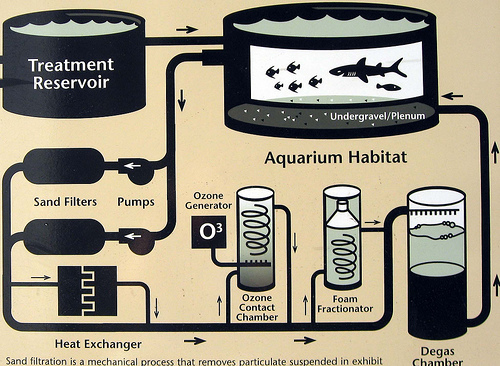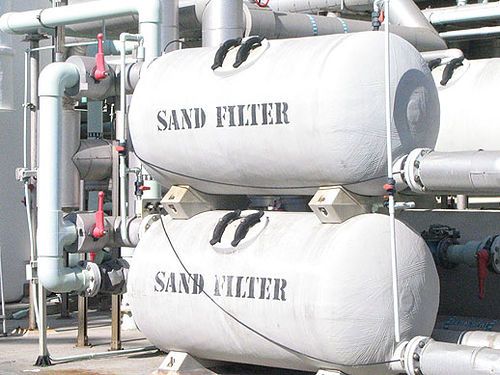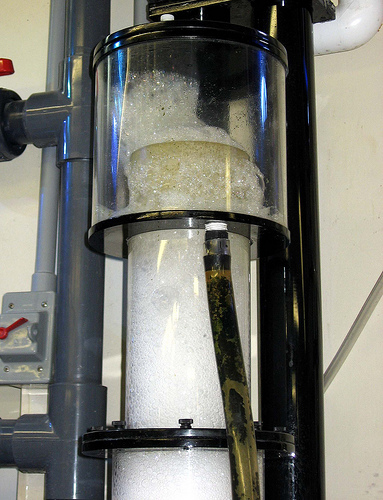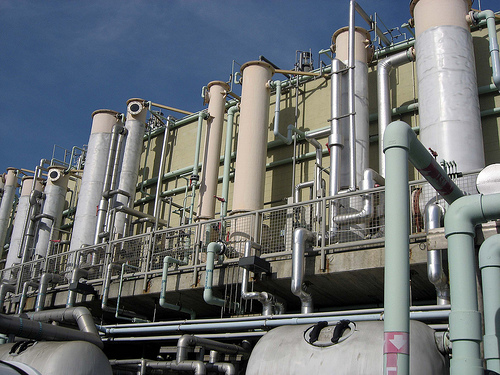The ABC’s of Filtration at the Aquarium

There are quite a few steps to filtration here at the Aquarium! Credit: Staci Peters
Retired
Staci
Tuesday, June 17, 2008
Whether you’re maintaining an exhibit that holds 200 gallons or 200,000 gallons, filtration is an integral part of any successful man-made marine habitat. Recently, I mentioned that the Aquarium filters approximately 1,000,000 gallons of salt water per hour to support over 12,000 marine residents. Why is filtration necessary? Fortunately, Liz Keenan with the Education Department provided me with a wealth of information on filtration practices in effect at the Aquarium of the Pacific that I would love to share with you!
Like all living creatures, marine animals give off waste products. These waste products will eventually break down into ammonia, which can be highly toxic to marine animals. In nature, the ocean is so large that the waste can be diluted into very low concentrations. In an aquarium environment, however, it would not take long for concentrations of ammonia to reach highly toxic levels. At the Aquarium, we take advantage of something called the “nitrogen cycle” to prevent ammonia levels from becoming too high in our exhibits. The nitrogen cycle (or nitrification cycle) converts toxic ammonia into other less harmful nitrogen compounds. Fortunately, nature has provided us with bacteria that can perform this process for us! These bacteria will convert ammonia into nitrite and then eventually to nitrate, which is relatively harmless to the animals in our exhibits as long as regular water changes are performed. The Aquarium uses three main types of filtration: mechanical, chemical, and biological.
Mechanical filtration is the removal or straining of solid particles from the water. Unfortunately, mechanical filtration cannot remove dissolved ammonia from the water. It can, however, remove solid waste particles from the water before they have a chance to break down into ammonia. Mechanical filters catch and hold particles by physically trapping them within the filter. The composition of the media within the filter is directly related to the type and size of particle the filter can remove. Fine filters can capture very small particles but clog easily and must be cleaned regularly in order to maintain good water flow. Coarse filters capture fewer particles but clog more slowly. Mechanical filter media can be in the form of sponges, loose bonded floss, foam, or even sand. A good mechanical filter is one that traps many solids, keeping the water clear, without clogging up too often.
Chemical filtration is the second type of filtration. This type of filtration removes wastes (proteins and organics) from the water before they have a chance to decompose. These dissolved products are ones that can no longer be removed by mechanical filters. Chemical filtration in a way is mechanical filtration on a molecular level.
One method of chemical filtration is protein skimming or foam fractionation. Protein skimming takes advantage of the polar nature of organic molecules, attracting them to the surface of air bubbles shot into a column of water. The foamy solution then rises to the surface where it is skimmed off. Because some complex compounds or organic compounds have hydrophobic (“disliking water”) and hydrophilic (“loving water”) ends, these dissolved organics are attracted to the interface between a gas and a liquid. The hydrophobic end is attracted to the interface and attaches to the surface of the bubble as it rises to the surface.
Another type of chemical filtration that we employ at the Aquarium is ozone. Ozone is the tri-atomic form of oxygen. Ozone is introduced into the water by passing air through an electrical discharge just before injection into the water. As the ozone breaks down in the water it reacts with dissolved organics as well as bacteria and parasites. Ozone, however, can be dangerous to marine creatures, causing the burning of the gills of fish and the delicate tissues of invertebrates. In extreme cases ozone can even cause death. Because of this, ozone must be removed from the water. Ozone is very unstable so it quickly bubbles out of the water inside the degas chambers. The tower in which the ozone is injected is called the contact chamber, while the tower in which it is removed is called the degassing chamber.
Biological filtration is the third type of filtration used at the Aquarium. This process was briefly covered at the beginning of this post while discussing the nitrogen cycle. Biological filtration allows the aquarists to employ nature’s nitrogen cycle and break down ammonia into relatively less toxic nitrogen compounds. This type of filtration does not remove wastes from the water; it merely transforms them into less toxic substances. These substances, like nitrate, are relatively harmless unless allowed to build up to high concentrations and, therefore, must be removed in regular, partial water changes. Mother Nature has provided us with the bacteria that breaks down ammonia, so all we need to do is provide a medium for them on which to grow!
The biotower is one example of biological filtration. Biotowers contain many small bioballs, which are usually small, plastic structures that have lots of surface area on which the bacteria can grow. These filters trickle water slowly over the bioballs and are often called wet/dry filters.
An under gravel filter is another type of biological filtration. Under gravel filters draw water through the bottom media, providing a surface where nitrifying bacteria can grow. Under gravel filters can be a problem, however, since they can clog easily with debris and organic matter that settle to the bottom.
Live rock is an important method of biological filtration used at the Aquarium of the Pacific. Live rock is basically rocks or dead coral that have broken off the reef and contain a vast array of small invertebrates and beneficial bacteria. Live rock contains a multitude of bacteria on both the exterior and interior of the rock. Because of these large quantities of bacteria, live rock is a perfect medium for biological filtration.
Whew! What a heap of information! Lots of work goes into keeping the Aquarium running smoothly, and hopefully you understand a little more about our filtration practices than you did before. If you’d like to see the filtration systems described here in person, as well as a lot of other neat things, come on in for a visit and take a behind-the-scenes tour. It’s a great opportunity to have fun while learning a lot!

Sand filters are a perfect example of mechanical filtration. Credit: Staci Peters

Protein skimming (foam fractionation) in action. See all the organic matter accumulating at the top? That's the waste that was pulled from the water. Credit: Staci Peters

Ozone contact and degas chambers behind-the-scenes. Credit: Staci Peters

